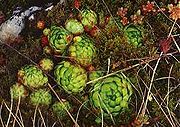
Hen and chicks
Encyclopedia


Succulent plant
Succulent plants, also known as succulents or fat plants, are water-retaining plants adapted to arid climates or soil conditions. Succulent plants store water in their leaves, stems, and also in roots...
belonging to the flowering plant
Flowering plant
The flowering plants , also known as Angiospermae or Magnoliophyta, are the most diverse group of land plants. Angiosperms are seed-producing plants like the gymnosperms and can be distinguished from the gymnosperms by a series of synapomorphies...
family Crassulaceae
Crassulaceae
Crassulaceae, or the orpine family, are a family of dicotyledons. They store water in their succulent leaves. They are found worldwide, but mostly occur in the Northern Hemisphere and southern Africa, typically in dry and/or cold areas where water may be scarce...
, native to Europe
Europe
Europe is, by convention, one of the world's seven continents. Comprising the westernmost peninsula of Eurasia, Europe is generally 'divided' from Asia to its east by the watershed divides of the Ural and Caucasus Mountains, the Ural River, the Caspian and Black Seas, and the waterways connecting...
and northern Africa
Africa
Africa is the world's second largest and second most populous continent, after Asia. At about 30.2 million km² including adjacent islands, it covers 6% of the Earth's total surface area and 20.4% of the total land area...
. They grow close to the ground with leaves formed around each other in a rosette
Rosette (botany)
In botany, a rosette is a circular arrangement of leaves, with all the leaves at a single height.Though rosettes usually sit near the soil, their structure is an example of a modified stem.-Function:...
, and propagating by offsets
Offsets
In botany and horticulture Offset is a term used to describe a small virtually complete daughter plant that has been naturally asexually produced on the mother plant. They are clones , meaning that they are genetically identical to the mother plant. In the plant nursery business and gardens they...
. The "hen" is the main plant, and the "chicks" are the offspring, which start as tiny buds on the main plant and soon sprout their own roots, taking up residence close to the mother plant.
Hen and chicks is also the popular name of a strain of opium poppy
Opium poppy
Opium poppy, Papaver somniferum, is the species of plant from which opium and poppy seeds are extracted. Opium is the source of many opiates, including morphine , thebaine, codeine, papaverine, and noscapine...
, Papaver somniferum, in which the seed head is surrounded by clusters of smaller heads.
Other types
Plants commonly referred to as "Hens and chicks" include ground hugging species of Sempervivum (Houseleeks) such as Sempervivum Pekinese, Sempervivum arachnoideumSempervivum arachnoideum
Sempervivum arachnoideum, sometimes known as cobweb houseleek, is a perennial plant of the genus Sempervivum. Its name arachnoideum refers to its furry central rosettes, resembling spider webs....
(Cobweb Houseleek), and Sempervivum tectorum
Sempervivum tectorum
Sempervivum tectorum is a succulent evergreen perennial whose many common names include Common houseleek,Jove's beard, Jupiter's eye, Thor's beard, St. George's Beard, and...
(Common Houseleek); and the related genus Jovibarba
Jovibarba
Jovibarba is a small genus of three species of succulents in the family Crassulaceae, endemic to mountainous regions in the southeastern quadrant of Europe. The genus is closely related to Sempervivum. Some taxonomists classify it as a subgenus of Sempervivum...
. The name is also used for some species of Echeveria
Echeveria
Echeveria is a large genus of succulents in the Crassulaceae family, native from Mexico to northwestern South America. The genus is named after the 18th century Mexican botanical artist Atanasio Echeverría y Godoy...
, Sedum
Sedum
Sedum is a large genus of flowering plants in the family Crassulaceae, members of which are commonly known as stonecrops. It contains around 400 species of leaf succulents that are found throughout the Northern Hemisphere, varying from annual and creeping herbs to shrubs. The plants have...
and Bergenia
Bergenia
Bergenia is a genus of ten species of flowering plants in the family Saxifragaceae, native to central Asia, from Afghanistan to China and the Himalayan region...
although these plants differ significantly from, and should not be confused with, Sempervivum and Jovibarba
Jovibarba
Jovibarba is a small genus of three species of succulents in the family Crassulaceae, endemic to mountainous regions in the southeastern quadrant of Europe. The genus is closely related to Sempervivum. Some taxonomists classify it as a subgenus of Sempervivum...
. The description below provides characteristics of Sempervivum and Jovibarba
Jovibarba
Jovibarba is a small genus of three species of succulents in the family Crassulaceae, endemic to mountainous regions in the southeastern quadrant of Europe. The genus is closely related to Sempervivum. Some taxonomists classify it as a subgenus of Sempervivum...
only.
Description
Aside from the common morphology, the many species of hen and chicks differ widely in appearance. Colours range from lime green to burgundy to purple, and size varies from as small as 1 cm to as large as 20 cm across. The leaves can be thin and spiky or thick and rounded with a pointed tip. Some, such as Cobweb Houseleek, have fine spiderweb-like filaments that grow naturally from leaf edge to leaf edge, forming a white cover on the top of the plant, while others have fine hairs that cover the entire plant structure.Upon maturity (usually around three to four years old) the plant will send up a single stalk that can reach 5-25 cm tall. The head of the stalk is a cluster of star-shaped flower buds 1-2 cm in diameter, which range in color from dark pink to yellow and that flower for several weeks. After blooming, the plant will die. Usually by this time it has produced many offsets ('chicks').

